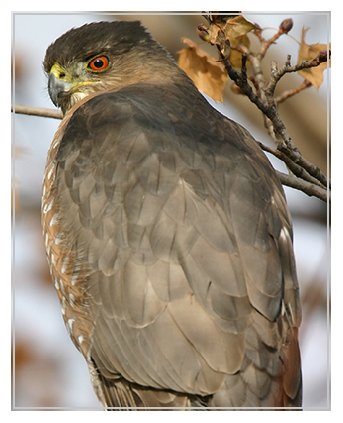 Cooper's hawk (Accipiter cooperii) is a medium-sized hawk and largish for an Accipiter. Compared to related species, they tend to have moderate-length wings, a long, often graduated, or even wedge-shaped tail and long though fairly thick legs and toes. Their eyes tend to be set well forward in the sides of the relatively large and squarish-looking head (though the head can look somewhat rounded if the feathers on the nape are held flush) and a relatively short but robust bill. They have hooked bills that are well adapted for tearing the flesh of prey, as is typical of raptorial birds.
Cooper's hawk (Accipiter cooperii) is a medium-sized hawk and largish for an Accipiter. Compared to related species, they tend to have moderate-length wings, a long, often graduated, or even wedge-shaped tail and long though fairly thick legs and toes. Their eyes tend to be set well forward in the sides of the relatively large and squarish-looking head (though the head can look somewhat rounded if the feathers on the nape are held flush) and a relatively short but robust bill. They have hooked bills that are well adapted for tearing the flesh of prey, as is typical of raptorial birds.
Generally, Cooper's hawks can be considered secretive, often perching within the canopy, but can use more open perches, especially in the western part of the range or in winter when they may use leafless or isolated trees, utility poles or exposed stumps. On perched hawks, the wing-tips tend to appear to cover less than one-third of the tail, sometimes seeming to barely cover the covert feathers.
As adults, they may be a solid blue-gray or brown-gray color above. Adults usually have a well-defined crown of blackish-brown feathers above a paler nape and hindneck offset against their streaked rufous cheeks. Their tail is blue-gray on top and pale underneath, barred with three black bands in a rather even pattern and ending in a rather conspicuous white tip. The adult’s underside shows a bit of whitish base color overlaid heavily with coarse, irregular rufous to cinnamon bands, though these narrow into marginal shaft streaks around the throat. Against the rich color on the rest of the underside, the pure white crissum on adults is conspicuous. Adult females may average slightly more brownish or grayish above, while some adult males can range rarely into almost a powder blue color. Although little regional variation is known in the plumage, adult coloring in the Pacific Northwest averages slightly darker overall. Aberrant pale plumage was recorded in at least four total birds of both sexes, all of which were almost completely white and lacked any underside streaking. These birds had faded back color and lacking strong barring on the tail. An aberrant dark female was also recorded. As a juvenile, she had a blackish-brown (rather than mid-brown) back and dark inky feathers below with grayish ground color barely showing. Later she produced an aberrant male with similar characteristics that successfully fledged. The latter two were possible cases of melanism and such dark variations are virtually unprecedented in any Accipiter species.
